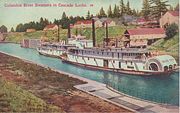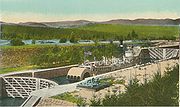
Cascade Locks and Canal
Encyclopedia

Columbia River
The Columbia River is the largest river in the Pacific Northwest region of North America. The river rises in the Rocky Mountains of British Columbia, Canada, flows northwest and then south into the U.S. state of Washington, then turns west to form most of the border between Washington and the state...
between the U.S. state
U.S. state
A U.S. state is any one of the 50 federated states of the United States of America that share sovereignty with the federal government. Because of this shared sovereignty, an American is a citizen both of the federal entity and of his or her state of domicile. Four states use the official title of...
s of Oregon
Oregon
Oregon is a state in the Pacific Northwest region of the United States. It is located on the Pacific coast, with Washington to the north, California to the south, Nevada on the southeast and Idaho to the east. The Columbia and Snake rivers delineate much of Oregon's northern and eastern...
and Washington, completed in 1896. It allowed the steamboats of the Columbia River
Steamboats of the Columbia River
Many steamboats operated on the Columbia River and its tributaries, in the Pacific Northwest region of North America, from about 1850 to 1981. Major tributaries of the Columbia that formed steamboat routes included the Willamette and Snake rivers...
to bypass the Cascades Rapids
Cascades Rapids
The Cascades Rapids were an area of rapids along North America's Columbia River, between the U.S. states of Washington and Oregon. Through a stretch approximately wide, the river dropped about in .-Boat portage:Boat travelers were forced to either portage boats and supplies or pull boats up with...
, and thereby opened a passage from the lower parts of the river as far as The Dalles
The Dalles, Oregon
The Dalles is the largest city and county seat of Wasco County, Oregon, United States. The name of the city comes from the French word dalle The Dalles is the largest city and county seat of Wasco County, Oregon, United States. The name of the city comes from the French word dalle The Dalles is...
. The locks were submerged and rendered obsolete in 1938, when the Bonneville Dam
Bonneville Dam
Bonneville Lock and Dam consists of several run-of-the-river dam structures that together complete a span of the Columbia River between the U.S. states of Oregon and Washington at River Mile 146.1. The dam is located east of Portland, Oregon, in the Columbia River Gorge. The primary functions of...
was constructed, along with a new set of locks
Lock (water transport)
A lock is a device for raising and lowering boats between stretches of water of different levels on river and canal waterways. The distinguishing feature of a lock is a fixed chamber in which the water level can be varied; whereas in a caisson lock, a boat lift, or on a canal inclined plane, it is...
, a short ways downstream.
Design and construction
As rail competition grew, and forced steamboats off their old routes, shippers and steamboat lines began agitating Congress to allocate funds for improvements to the river, in the form of canals and locks, that would restore their competitive position relative to the railroads. The two main improvements sought on the Columbia were the Cascade Locks and, about twenty years later, the Celilo CanalCelilo Canal
Celilo Canal was a canal connecting two points of the Columbia River between the states of Oregon and Washington, U.S. just east of The Dalles....
and Locks.
Studies for a canal at the Cascades had begun in 1875, but interest tapered off when Oregon Railroad and Navigation Company
Oregon Railroad and Navigation Company
The Oregon Railroad and Navigation Company was a railroad that operated a rail network of of track running east from Portland, Oregon, United States to northeastern Oregon, northeastern Washington, and northern Idaho...
(O.R.& N.) finished the railroad to The Dalles and took its boats off the middle river. Anti-monopoly shippers eventually got Congress to allocate funds in 1893 to begin the canal and locks at the Cascades
Cascade Locks, Oregon
Cascade Locks is a city in Hood River County, Oregon, United States. The city took its name from a set of locks built to improve navigation past the Cascades Rapids of the Columbia River. The U.S. federal government approved the plan for the locks in 1875, construction began in 1878, and the locks...
, which were completed in November 1896. The locks had a lift chamber carved in solid rock 460 feet (140.2 m) long, and 90' wide, with 8 feet (2.4 m) of draft, deep enough for any vessel then on the river, and large enough to accommodate several at once. The locks could raise a vessel 14' at high water and 24' at low water.
The lock gates were 56 feet (17.1 m) wide and 90 feet (27.4 m) high. The locks were carefully designed to address the great variation in the height of the river, the difference between high and low water being 55 feet (16.8 m). This condition made it necessary to build a series of three sets of gates, increasing in height from the lower entrance to the huge upper guard gate, only two sets being used at one time. When the river was low, the upper guard gates remained open continually and the lower sets were operated. When the water rose enough to drown the lower gates, they were swung open and the lifting work was done by the others. The upper approach was formed by masonry wall extending from the guard gate in a long sweep of 1200 feet (365.8 m), and the bank behind was armored against floods with riprapped stone.
Effect on river traffic

As it turns out, completion of the locks and the 3000 feet (914.4 m) canal leading from the east end of the locks, produced some increase in traffic, but not as much increase in riverine traffic as had been hoped. The North Bank railroad was also completed along the Columbia, which took more business away from the boats. As a result, the Regulator Line, which had been running Dalles City, Regulator, and Bailey Gatzert
Bailey Gatzert (sternwheeler)
The Bailey Gatzert was a famous sternwheel steamboat that ran on the Columbia River and Puget Sound from the 1890s to the 1920s. She was named after Bailey Gatzert, an early businessman and mayor of Seattle...
on the lower Columbia, and, through the locks, on the middle Columbia, sold out to James J. Hill
James J. Hill
James Jerome Hill , was a Canadian-American railroad executive. He was the chief executive officer of a family of lines headed by the Great Northern Railway, which served a substantial area of the Upper Midwest, the northern Great Plains, and Pacific Northwest...
, owner of the Great Northern and other railroads. Not long later, in 1912, the Panama Canal Act made it illegal for a railroad to be owned in common with a competing steamboat line, so in 1915, Great Northern sold its boats.
Current status
The lower lock and the canal were flooded when the Bonneville DamBonneville Dam
Bonneville Lock and Dam consists of several run-of-the-river dam structures that together complete a span of the Columbia River between the U.S. states of Oregon and Washington at River Mile 146.1. The dam is located east of Portland, Oregon, in the Columbia River Gorge. The primary functions of...
was completed in the 1930s. The upper part of the higher lock is still visible and part of Cascade Locks Marine Park in the city of Cascade Locks, Oregon
Cascade Locks, Oregon
Cascade Locks is a city in Hood River County, Oregon, United States. The city took its name from a set of locks built to improve navigation past the Cascades Rapids of the Columbia River. The U.S. federal government approved the plan for the locks in 1875, construction began in 1878, and the locks...
. The park is listed on the National Register of Historic Places
National Register of Historic Places
The National Register of Historic Places is the United States government's official list of districts, sites, buildings, structures, and objects deemed worthy of preservation...
.
See also
- Celilo CanalCelilo CanalCelilo Canal was a canal connecting two points of the Columbia River between the states of Oregon and Washington, U.S. just east of The Dalles....
- Columbia Gorge
- Fort CascadesFort CascadesFort Cascades was a United States Army fort constructed in 1855 to protect the portage road around the final section of the Cascades Rapids, known as the "lower cascades." It was built on the Washington side of the Columbia River, between the present site of North Bonneville and the Bonneville...
- Steamboats of the Columbia RiverSteamboats of the Columbia RiverMany steamboats operated on the Columbia River and its tributaries, in the Pacific Northwest region of North America, from about 1850 to 1981. Major tributaries of the Columbia that formed steamboat routes included the Willamette and Snake rivers...
- Shaver Transportation CompanyShaver Transportation CompanyThe Shaver Transportation Company is an inland water freight transportation company based in Portland, Oregon, United States. The company was founded in 1880, and played a major role in the development of freight transport in the Portland area and along the Columbia., Harry L...
Photographs
- Construction of Cascades Locks, 12/01/1883
- Looking east toward Cascades Locks, 1914
- Dalles City, Regulator and another, unidentified, sternwheeler passing through Cascade Locks
- Charles Spencer near Cascade Locks
- Maria, Dalles City, Harvest Queen and Sarah Dixon waiting to lock through on the opening day of Cascades Locks, November 8, 1896
- tinted postcard showing Bailey Gatzert entering Cascade Locks from the east
- Cascade Locks from the west, possibly taken from the Bridge of the Gods
- photo looking upriver showing Bridge of the Gods with Cascade Locks on right
- Dalles City, Regulator, and one other steamboat in Cascade Locks This photograph clearly shows the size of the locks in comparison to the size and number of boats in them.

